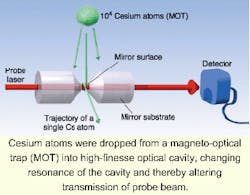Microscopy: Atom-cavity microscope resolves 2 µm in 10 µs
As often happens in the world of science, researchers at the California Institute of Technology (Pasadena, CA) and Auckland University (Auckland, New Zealand) were looking for one thing and serendipitously stumbled across an ingenious way to look for something else. The original goal was to control atom—photon interactions as closely as possible to facilitate operations of quantum logic. The outcome is a potential microscopy tool—an atom-cavity microscope—that unlike many other microscopy methods is not limited to observing stationary objects on plane surfaces.
"It was one of those experiments that was moving toward one thing and picked up another aspect along the way," said Theresa Lynn, a graduate student in the Cal Tech group. A primary initial motivation was to eventually perform quantum communication by mapping information from an atom in one cavity onto a separate atom in another cavity using the strong quantum mechanical interaction between atoms and light. What they found, however, was that the light signal coming out of the cavity also gave a precise description of the position of the atom.
The basic experimental mechanism consisted of a 10-µm-wide optical cavity bounded by two highly reflective mirrors and illuminated by an 852-nm circularly polarized probe laser. A magneto-optical trap 3 mm above the cavity was used to feed single atoms into the cavity. Because of the small size of the cavity and high reflectivity of the mirrors, a single photon entering the cavity would be reflected approximately 480,000 times before escaping, thereby causing a strong electrical field and trapping the atom (see figure).
The atom and the light interact as a result of the strong quantum-mechanical force between them. "So if you modulate the intensity of the light, for instance, then you are changing the forces on the atom and actively controlling its position," Lynn said. "In the future, we're looking toward implementing a feedback loop where you know exactly what the atom is doing at any time and therefore know exactly how to modulate the light to cool the atom down and keep it in the center."
At the same time, the presence of a single atom inside the cavity also changes the resonance properties of the cavity, she said. "For instance, if you're sending resonant light into the cavity and measuring some transmission, once an atom goes in there you won't get that transmission any more because it's no longer resonant." The researchers used this quality to monitor the cavity with a weak probe signal that would not resonate with the cavity until an atom had entered. When an atom entered, the weak output increased and signaled the researchers to increase the source intensity enough to trap the atom.
The researchers did not realize until they actually began to observe the system in operation, however, that the sensitivity to atomic motion would yield measurements of atom position with 2 µm of spatial resolution over a 10-µm interval, providing a sensitivity near the quantum limit for motion sensing.1
"Initially when we did this we didn't know that we were going to be able to reconstruct the motion of the atoms inside the cavity in the [precise] way that we were able to," Lynn said. One of the reasons that the researchers were able to measure these minute atomic oscillations was that they had spent about a year prior to the experiment perfecting the mechanical stability of the optical cavity to prevent spurious signals generated by movement of the mirrors.
In addition to potential applications in the original area of interest, quantum electrodynamics, the atom-cavity microscope may eventually find use in biological applications, Lynn said. Currently, the research team is also investigating the possibility of using a dipole or magnetic trap in the system that would free the quantum field for experimental manipulations of the internal state of the atom that might include changes of frequency or on-off modulation.
REFERENCE
- C. J. Hood et al., Science 287, 1447 (28 Feb. 2000).
About the Author
Hassaun A. Jones-Bey
Senior Editor and Freelance Writer
Hassaun A. Jones-Bey was a senior editor and then freelance writer for Laser Focus World.
